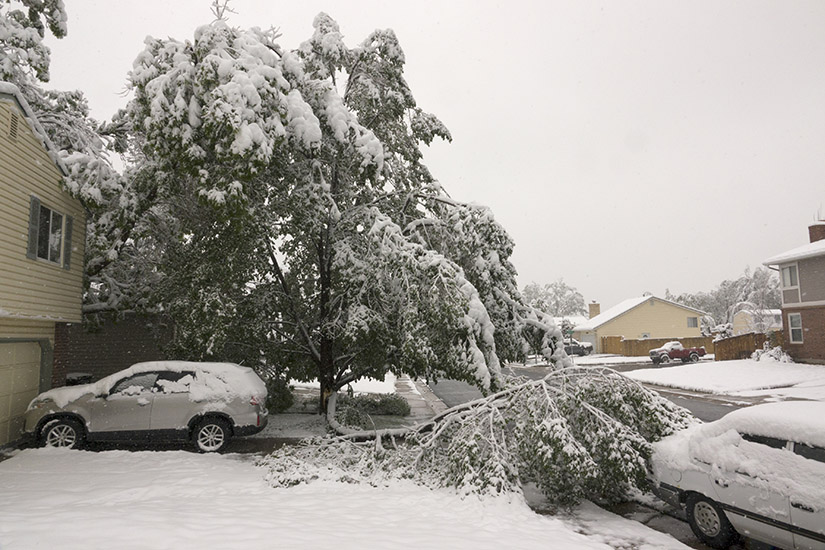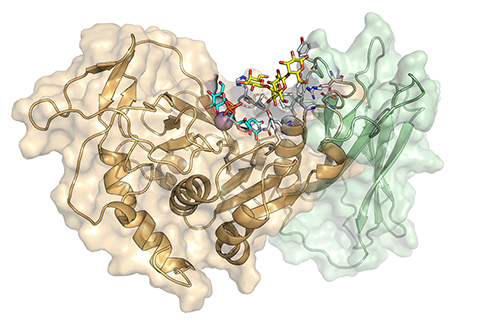A Pectin-Synthesizing Enzyme May Help Trees Weather Storms. Could It Be Key to More Sustainable Bioproducts?
Scientists Characterize a Galactan Synthase (GalS1) Enzyme Involved in Pectin Synthesis

A study in plant biochemistry—How do trees build tissues capable of withstanding the worst weather? Photo from iStock
Spring means snowstorms for much of the country, which can bring inches of heavy, wet snow. Tree branches sag, and a few snap—but most bounce back quickly with the warming spring sun.
Plant cells contain high amounts of lignin, cellulose, and hemicellulose, which are the primary building blocks of plant stems and trunks. Much less is known, however, about a crucial fourth polymer: pectin, thought to provide strength and flexibility by interconnecting with the other three components.
What has particularly puzzled scientists is exactly how plants build the pectin components of the cell wall.
Now, researchers from the National Renewable Energy Laboratory (NREL), the University of Georgia, and Lawrence Berkeley National Laboratory have discovered the biological mechanism involved in making one specific component of pectin. Published in Nature Plants, an article details the structure and biochemical activity of the enzyme Galactan Synthase 1 (GalS1), an enzyme involved in turning the sugar galactose into its polymeric form, called galactan—an important pectin component.
“If you ask most people in the biofuels industry about the major components of plant cell walls, they will tell you cellulose, hemicellulose, and lignin,” said Yannick Bomble, an NREL biophysicist. “Pectin is often overlooked unless you talk to a plant scientist, but it’s a very essential component of any plant.”
The study is funded by the Center for Bioenergy Innovation, from the U.S. Department of Energy (DOE) Bioenergy Research Centers supported by the Office of Biological and Environmental Research in DOE’s Office of Science. It complements the team’s other recent work that details different processes in plant biopolymer synthesis. Together, they provide a picture on how plant enzymes work together to build complex polymers—polymers that scientists might someday modify to more easily extract useful cell wall components from biomass or manufacture sustainable bioproducts.
GalS1 Decorates Pectin With Sidechains of Arabinose and Galactose Sugars
To create flexible limbs, deep roots, and sturdy trunks, plant enzymes work in tandem to reconfigure raw resources like sugars into polymers they can later use as building materials for their cell walls. Among the many enzymes involved in these processes, GalS1 performs a specific role: It links galactose sugar molecules together onto a long pectin chain at specific locations, almost like fastening tree branches to a central trunk.

The result is a structurally complex molecular component of pectin. According to Vivek Bharadwaj, an NREL computational scientist, researchers have struggled to understand plant enzymes, such as GalS1, involved in making polymers like pectin.
“We wanted to understand, at the atomistic level, how the substrates bind at the active site and the mechanisms by which the sugar gets attached to increase the chain length of the galactan branch,” he said. “That’s really traditionally been tough to do experimentally, which is where NREL came in.”
Using computational tools, Bharadwaj and Bomble provided an unprecedentedly detailed look at both the structure of the enzyme and its biochemistry. That effort revealed specifics on how and where the substrates bind, as well as what biological machinery GalS1 uses to complete such specific biochemical tasks.
They found that GalS1 is unique, containing a special module that lets it bind to a pectin backbone laid down by other enzymes. Once attached, GalS1 positions its catalytic domain to start stacking sugars, one on top of another. The resulting branches—comprised of galactan chains that are terminated with arabinose—provide unique structure and function to the resulting pectin. Large quantities of galactose are observed in tension wood, for example—a form of wood especially adept at weathering the elements.
Could Bendy Trees Make Better Biofuels?
So why all that trouble to understand a single enzyme with a very specific role? According to Bomble, the long-term goal is being able to tweak the concentrations of sugars in plant cell walls generally and in pectin and hemicelluloses more precisely.
“We want to be able to control the ratio of all the different components to give lignocellulosic materials the properties that we want,” Bomble explained.

A team effort—Yannick Bomble (left) and Vivek Bharadwaj (right) were part of a multi-institutional team, which enabled them to pool expertise and capabilities. Photo by NREL
Overexpressing or modifying enzymes like GalS1 could influence the properties of cell walls, changing the chemical composition of pectin and other key polymers. For example, GalS1 might be one of the enzymes involved in imparting extra flexibility in key areas of a plant, such as in tree limbs susceptible to a spring snowstorm.
Bomble said that scientists in the future might be able to modify GalS1 to add even more galactose, or even glucose, favored in processes for making biofuels.
“Microbes usually have an easier time converting C6 sugars, like galactose, than C5 sugars, like arabinose,” he said. “It would be better to have higher concentrations of C6 sugars in the plant cell wall to upgrade them into useful products.”
Of course, Bomble and Bharadwaj caution that effectively modifying enzymes will require many more focused, peer-reviewed scientific studies. As Bharadwaj said, “What will happen to the strength of these plant cell walls when you shift that C5 to C6 ratio? We don't know enough about it.”
For now, next time you see branches rocking in the wind or flexing under the snow, think about GalS1 and the numerous other enzymes needed to achieve the feat. Those same enzymes could hold the keys to more efficient, cost-effective routes to sustainable biofuels and bioproducts.
Learn about NREL’s other bioenergy research.
Last Updated May 28, 2025
